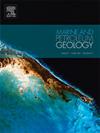松辽盆地中部坳陷白垩系青山口组一段页岩白云岩成因及地质意义
IF 3.6
2区 地球科学
Q1 GEOSCIENCES, MULTIDISCIPLINARY
引用次数: 0
摘要
本文首次对松辽盆地中央坳陷白垩系青山口组一段不同成熟度的白云岩矿物进行了纳米、微观和宏观尺度的分析(此处所有成熟度均与有机质成熟度有关)。结合矿物学、岩石学、同位素和元素分析,阐明了孔隙流体演化和白云岩成岩作用及其对页岩有机质和储层空间的指示意义。确定了三种自生白云岩类型。早成岩—中成岩时期自生白云岩的析出顺序为:低成熟白云岩中菱形白云岩(Ro: 0.58 ~ 0.70%)→中成熟白云岩中菱形白云岩在菱形白云岩上形成过长(Ro: 0.78 ~ 1.29%)→高成熟白云岩中裂缝中的鞍形白云岩(Ro: 1.34 ~ 1.70%);伴随孔隙流体由海水向有机流体转变,继而向高温热液流体转变。早成岩至中成岩A1期,海水中的产甲烷古菌诱导白云岩沉淀,阻止了压实过程中颗粒间孔隙的破坏,保存了低成熟白云岩页岩的微孔。在中成岩A2期,菱形铁白云岩的胶结作用降低了中成熟白云岩页岩的有效孔隙度,消耗了有机碳作为碳架。排烃环境中,有机酸对菱形铁白云岩的溶蚀作用促进了微纳米级溶蚀孔的发育,增加了有效孔隙度,有利于中成熟白云岩页岩排烃。在中成岩B期,高温热液虽然导致鞍状铁白云岩胶结封堵裂缝,但热液和(或)埋藏提供的热源促进了有机质的热解和有机孔隙的发育,提高了高成熟度白云岩页岩的有效孔隙度和排烃能力。因此,低成熟白云岩页岩的有效孔隙度和总有机碳(TOC)含量高于中、高成熟白云岩页岩。该研究将优质页岩从传统的高成熟条件下的有机孔隙区扩展到低成熟条件下有机质富集的无机孔隙区,对开发页岩油气勘探领域具有重要意义。本文章由计算机程序翻译,如有差异,请以英文原文为准。
Genesis and geological significance of dolomite in shales of the first member of the cretaceous Qingshankou Formation, central depression, Songliao Basin, China
This study presents the first nano-, micro-, and macro-scale analyses of dolomite minerals of varying maturity (all references to maturity in this study pertain to the maturity of organic matter) sampled from the first member of the Cretaceous Qingshankou Formation in the central depression of the Songliao Basin, China. Mineralogical, petrological, isotope and elemental analyses were combined to elucidate the pore fluid evolution and dolomite diagenesis, as well as their implications for the shale organic matter and reservoir space. Three types of authigenic dolomites are identified. The precipitation of authigenic dolomite during the early diagenesis to the mesodiagenesis followed the sequence of anhedral dolomite in low-maturity dolomitic shale (Ro: 0.58–0.70 %) → rhombic ankerite formed overgrowths on anhedral dolomite in medium-maturity dolomitic shale (Ro: 0.78–1.29 %) → saddle-shaped ankerite in crack in high-maturity dolomitic shale (Ro: 1.34–1.70 %); this was accompanied by the transition of pore fluid from seawater to organic fluid, and subsequently to high-temperature hydrothermal fluid. During the early diagenesis to the A1 stage of mesodiagenesis, the methanogenic archaea in seawater induced the precipitation of anhedral dolomite, which prevented interparticle pore destruction during compaction and preserved the micropores in low-maturity dolomitic shales. During the A2 stage of mesodiagenesis, the cementation of rhombic ankerite decreased the effective porosity, and consumed organic carbon as the carbon framework in the medium-maturity dolomitic shales. In the hydrocarbon expulsion environment, the dissolution of rhombic ankerite by organic acids promoted the development of micro-nano-scale dissolution pores and increased the effective porosity, which facilitated the expulsion of hydrocarbons from the medium-maturity dolomitic shales. During the B stage of mesodiagenesis, although the high-temperature hydrothermal fluid led to the occlusion of cracks by the cementation of saddle-shaped ankerite, the heat source provided by hydrothermal fluids and/or burial promotes the pyrolysis of organic matter and the development of organic pores, which increased the effective porosity and the expulsion of hydrocarbons in the high-maturity dolomitic shales. Therefore, the low-maturity dolomitic shales exhibit higher effective porosity and higher total organic carbon (TOC) content compared to medium- and high-maturity dolomitic shales. This study expands the high-quality shale from the traditionally organic pore region in higher-maturity conditions to the inorganic pore region with the enrichment of organic matter in lower maturity conditions, which is crucial for developing the hydrocarbon exploration field of shale.
求助全文
通过发布文献求助,成功后即可免费获取论文全文。
去求助
来源期刊

Marine and Petroleum Geology
地学-地球科学综合
CiteScore
8.80
自引率
14.30%
发文量
475
审稿时长
63 days
期刊介绍:
Marine and Petroleum Geology is the pre-eminent international forum for the exchange of multidisciplinary concepts, interpretations and techniques for all concerned with marine and petroleum geology in industry, government and academia. Rapid bimonthly publication allows early communications of papers or short communications to the geoscience community.
Marine and Petroleum Geology is essential reading for geologists, geophysicists and explorationists in industry, government and academia working in the following areas: marine geology; basin analysis and evaluation; organic geochemistry; reserve/resource estimation; seismic stratigraphy; thermal models of basic evolution; sedimentary geology; continental margins; geophysical interpretation; structural geology/tectonics; formation evaluation techniques; well logging.
 求助内容:
求助内容: 应助结果提醒方式:
应助结果提醒方式:


